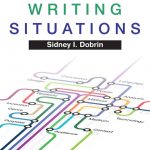Writing Situations
$139.99
| Title | Range | Discount |
|---|---|---|
| Trade Discount | 5 + | 25% |
- Description
- Additional information
Description
Bridge from everyday writing to writing in any situation.
College students write regularly in personal and social settings, but they often find it challenging to transition successfully to academic contexts. By building from their everyday writing experience, Writing Situations with MyWritingLab prepares students to analyze, navigate, and write effectively in any situation. Author Sid Dobrin presents a rhetorical situation both nuanced and practical, grounded not only in audience, purpose, and context but also impacted by medium, methodology, and relationships among stakeholders. Writing Situations provides a framework and a process for students to apply to any writing project and any situation.
0321881028 / 9780321881021 Writing Situations with NEW MyWritingLab with eText — Access Card Package
Package consists of:
0205735436 / 9780205735433 Writing Situations
0205870147 / 9780205870141 NEW MyWritingLab with Pearson eText — Valuepack Access Card
-
Robust resources improve students’ writing and allow instructors to track results. WithinMyWritingLab, students can measure how well they understand key concepts; the interactive Map Your Situation tool fosters rhetorical thinking and invention. Faculty can incorporate rubrics into meaningful assignments, grade based on desired criteria, and analyze class performance through advanced reporting.
-
Pedagogical support helps students master the writing process. Each project chapter includes five visual features that lead to an effective, efficient writing process by helping students to analyze, navigate, and respond to diverse writing situations.
-
Road to a Strong Thesis fosters analytic thinking by making visible a writer’s interior monologue about purpose, audience, and rhetorical situation when developing a strong thesis.
-
Side by Side develops analytic reading skills by comparing three readings in each chapter–one student authored and the other two professionally written–and spotlighting decisions each writer made when solving rhetorical problems in related situations.
-
Mapping your Situation helps students navigate any writing situation by suggesting questions to ask ranging from purpose, audience, medium, context, and networks, providing a starting point for planning and invention.
-
Prepare and Respond identifies characteristics of different kinds of writing and walks writers through steps for developing content of their own.
-
Writing Process Guidelines ensure students respond effectively to their writing situation: concrete action steps guide writers through their writing process from invention and research to drafting, revision, evaluation, and distribution.
-
-
Contemporary readings anthologized thematically rather than by genre type to better facilitate synthesis assignments include engaging and relevant topics: technology, image and culture, sustainability, education, food, and the millennial generation.
-
Next generation instructor support provides contextualized and integrated instructor support in the form of videos, screencasts, PowerPoints, downloads, handouts for each assignment chapter–organized by chapter and housed in one place for instructor ease of use.
-
A variety of writing assignments accommodate a range of teaching approaches.
-
Formal assignments in each project chapter facilitate flexible and ranging teaching approaches by including a traditional academic essay, a project focused on using visuals, an online or digital assignment, a research-based option, and a “radical revision/ translation” project to turn a print-based essay into a multimodal project.
-
End-of-chapter activities include “Reflection,” “Discussion Threads,” “Collaboration,” “Writing,” and “Local Situation.”
- Post-reading questions and prompts include “Analyzing the Situation,” “Analyzing the Rhetoric,” “Discussing,” and “Writing.”
-
Contents
Preface
Part One: Writing Processes
1. Understanding Rhetorical Situations
Writing in College
Rhetorical Situations
Rhetorical Ecology
Responding to Situations
A Situation of Writing
2. Purpose and Audience
Writing Processes
Rhetorical Purpose
Audience
Transnational Audiences
Visuals, Audience, and Purpose
3. Generating Ideas
Strategies for Getting Started
Reading
Thinking
Questioning
Writing
Remembering
Wandering
Discussing
Viewing
Dramatizing
Experimenting
4. Drafting and Organizing
Strategies for Drafting
Strategies for Organizing
Organizing by Time
Organizing by Type of Content
Organizing by Trait
Spatial Organization
5. Revising
Stages of Revising
Revising Globally
Revising Locally
Revise Your Visuals
Use Feedback to Revise
Part Two: Thinking, Reading, and Viewing
6. Thinking
Thinking
Intellectual Standards
Logic and Logical Fallacies
Problem Solving
Active Thinking
Networked Thinking
Visual Thinking
7. Reading and Viewing
Reading
Strategies for Active Reading
Strategies for Viewing
Part Three: Writing Projects
8. Writing to Narrate
Narration
Annotated Example: David P. Bardeen, “Lives, Not Close Enough for Comfort”
Student Example: Summer Woods, “A Southern State of Mind”
The Road to a Strong Thesis
Example: Diane Hamill Metzger, “The Manipulation Game: Doing Life in Pennsylvania”
Side by Side
Prepare and Respond
Visual Narrative: Matt Madden, from 99 Ways to Tell a Story: Exercises in Style
Mapping Your Situation
Literacy Narratives
Writing Projects
Essay ª Literacy Narrative ª Visual ª Digital ª Research ª Radical Revision
Visual Narratives
Writing Process Guidelines
Seeking Feedback
Thinking and Writing about the Chapter
Reflection ª Discussion Threads ª Collaborating ª Writing ª Local Situation
9. Writing to Describe
Description
Annotated Example: Rachel Carson, From The Edge of the Sea
Student Example: Ndidi Madu, “NCAA Tournament Experience”
The Road to a Strong Thesis
Example: Jeffrey Tayler, “The Sacred Grove of Oshogbo.”
Side by Side
Prepare and Respond
Mapping Your Situation
Search Engine Optimization
Writing Projects
Essay ª Visual ª Digital ª Research ª Radical Revision
Visuals That Describe
Writing Process Guidelines
Seeking Feedback
Thinking and Writing about the Chapter
Reflection ª Discussion Threads ª Collaborating ª Writing ª Local Situation
10. Writing to Inform
Informative Writing
Annotated Example: Contemporary Hispanic Biography, Celia Cruz
Student Example: Berthrude Albert, “The Stand Against Social Injustice: Projects For Haiti, Inc.”
The Road to a Strong Thesis
Example: Lisa Hix, “The Inside Scoop on the Fake Barf Industry.”
Side by Side
Prepare and Respond
Mapping Your Situation
Writing Projects
Essay ª Visual ª Digital ª Research ª Radical Revision
Visuals that Inform
Writing Process Guidelines
Seeking Feedback
Thinking and Writing about the Chapter
Reflection ª Discussion Threads ª Collaborating ª Writing ª Local Situation
11. Writing to Respond
Writing to Respond
Annotated Example: David Leavitt, “Men in Love: Is Brokeback Mountain a Gay Film?”
Student Example: Alexandra Bargoot, Argument in Response to “Importance of Education Lost in the Mix”
The Road to a Strong Thesis
Example: Ta-Nehisi Coates, “Nothing is So Necessary for a Young Man…”.”
Side by Side
Prepare and Respond
Two Common Organizational Strategies for Writing Responses
Mapping Your Situation
Writing Projects
Essay ª Visual ª Digital ª Research ª Radical Revision
Writing Process Guidelines
Seeking Feedback
Thinking and Writing about the Chapter
Reflection ª Discussion Threads ª Collaborating ª Writing ª Local Situation
12. Writing to Analyze
Analysis
Annotated Example: Tim Collins, “Straight from the Heart.”
Student Example: Emilia Maria “Nicky” Cadiz, “The Jersey Shore and Harper’s Bazaar.”
The Road to a Strong Thesis
Example: Annalee Newitz, “When Will White People Stop Making Movies like ‘Avatar’?”
Side by Side
Prepare and Respond
Mapping Your Situation
Writing Projects
Essay ª Visual ª Digital ª Research ª Radical Revision
Analyzing Visuals
Writing Process Guidelines
Seeking Feedback
Thinking and Writing about the Chapter
Reflection ª Discussion Threads ª Collaborating ª Writing ª Local Situation
13. Writing to Evaluate
Evaluation
Annotated Example: Edward C. Baig, “Review: Sony Tablet P Shows 2 Screens Aren’t Better than 1.”
Student Example: Quang Ly, “Have You Been Bitten? Evaluating the Twilight Craze.”
The Road to a Strong Thesis
Example: Sean McCoy, “Square Water Bottle Raises $126K on Kickstarter: We Test It Out”
Side by Side
Prepare and Respond
Developing Criteria for an Evaluation
Organizing an Evaluation
Mapping Your Situation
Writing Projects
Essay ª Visual ª Digital ª Research ª Radical Revision
Visuals and Evaluation
Writing Process Guidelines
Seeking Feedback
Thinking and Writing about the Chapter
Reflection ª Discussion Threads ª Collaborating ª Writing ª Local Situation
14. Writing to Argue
Argument
Formal Argumentation
Annotated Example: Pete Singer, “Animal Rights.”
Student Example: Lauren Brooke Horn, “The First-Year Dilemma: To Write or Not to Write?”
The Road to a Strong Thesis
Example: Tim Wise, “Whites Swim in Racial Preference.”
Side by Side
Prepare and Respond
Organizational Approaches to Argument
Mapping Your Situation
Visuals and Argumentation
Student Visual Example: Ian Rowe, “A Day in the Life of Your Child on Adderall”
Student Visual Example: Hyesu Grace Kim, “Self-Portrait”
Writing Projects
Essay ª Visual ª Digital ª Research ª Radical Revision
Writing Process Guidelines
Seeking Feedback
Thinking and Writing about the Chapter
Reflection ª Discussion Threads ª Collaborating ª Writing ª Local Situation
15. Writing to Propose
Writing to Propose
Annotated Example: Joan Didion, “In Bed”
Student Example: Eric Trotta, “Handling the Snakehead Invasion”
The Road to a Strong Thesis
Example: Paul Goodman, “A Proposal to Abolish Grading.”
Side by Side
Prepare and Respond
Organizational Approaches for Writing to Propose
Mapping Your Situation
College Research and Topic Proposals
Writing Projects
Essay ª Visual ª Digital ª Research ª Radical Revision
Visuals and Proposals
Writing Process Guidelines
Thinking and Writing about the Chapter
Reflection ª Discussion Threads ª Collaborating ª Writing ª Local Situation
Part Four: Writing Visuals
16. Finding, Adapting, and Making Visuals
Processes for Finding, Adapting, and Making Visuals
Finding and Adapting
Ethics and Locating/Adapting Visuals
Making Visuals
Student Example: “The Roman Baths of England: A Visual History,” Mariah O’Toole
17. Designing Documents
Document Design
Before: Traditional Report Format
After: Report Design Makeover
Understanding Design Processes
Part Five: Writing Research
18. Planning and Conducting Research
Research
Developing a Research Plan
Attributing Research
Developing Criteria for Analyzing and Evaluating Sources
Conducting Research
Using Library Resources
Using Online Resources
Conducting Primary Research
19. Evaluating and Synthesizing Information
Taking Notes
Evaluating Sources
Synthesis
Synthesizing Research
Quoting Research
Paraphrasing Research
Summarizing Research
When to Quote, Paraphrase, and Summarize
Avoid Plagiarism
20. Presenting and Documenting Research
Student Example: Summer Woods, “From Protest to Resistance”
Developing a Research Plan
Locating and Evaluating Resources
Mapping Your Research
Attributing and Documenting Sources
21. Responding to Essay Exams
Writing College-Level Essay Exams
Preparing for Essay Exams
Taking Essay Exams
Part Six. Readings
22. Technology
“The Telephone,” Anwar F. Accawi
“Is Google Making Us Stupid? What the Internet is doing to our Brains,” Nicholas Carr
“Does the Internet Make You Smarter?” Clay Shirky
“Outdoors and Out of Reach, Studying the Brain,” Matt Richtel
“I ♥ Novels,” Dana Goodyear
Joy of Tech, Nitrozac and Snaggy
“I Tweet Therefore I Am,” Peggy Orenstein
“A Death on Facebook: Intimacy and Loss in the Age of Social Media,” Kate Bolick
“Small Change: Why the Revolution will not be Tweeted,” Malcolm Gladwell
23. Image/Culture
“Graven Images,” Saul Bellow
“Mr. Palomar at the Beach—The Naked Bosom,” Italo Calvino
“Seduced by the Image of Reality,” NietzsChe Guevara
“Richard Drew, The Falling Man,” Tom Junod
Debate Grows over Use of Sexual Assault Photo, Michelle Goldberg
“The Revolution Will not be Televised,” Gil Scott-Heron
“The Television Will Not Be Revolutionized,” Lupe Fiasco (Wasalu Muhammad Jaco)
“Photography as a Weapon,” Errol Morris
A Tragedy that Won’t Fade Away, Jessica Bennett
Listening to Braille, Rachel Avivss
Citizens Protesting Anti-Semitic Acts, Billings Montana, Frederic Brenner
24. Sustainability
“Four Challenges of Sustainability,” David W. Orr
“Thinking Like a Mountain,” Aldo Leopold
“The Conundrum of Consumption,” Alan Thein Durning
“Save the Whales, Screw the Shrimp,” Joy Williams
“The Story of Stuff,” Annie Leonard
“The Story of E-Waste: What Happens to Tech Once It’s Trash,” Gord Gable
“Effort to Trace “Conflict Minerals” in Electronics,” Martin LaMonica
“Would You Like that Book in Paper or Plastic?” Erika Engelhaupt
“Caveman Science Fiction,” Aaron Diaz
“Tuna’s End,” Paul Greenberg
“How to Queer Ecology: One Goose at a Time, A Lesson Plan,” Alex Johnson
“Manufactured Landscapes,” Directed by Jennifer Baichwal
“Growing Up Global: Humanity’s Long Road to Sustainability,” Public Broadcast Service, Wide Angle
25. Education
“The Purpose of Higher Education,” Richard Kahlenberg
“The Five Purposes of Higher Education, “ Siobhan Curious
“Envisioning a Post-Campus America,” Megan McArdle
“Changing Education Paradigms,” Sir Ken Robinson
“Teachers without Technology Strike Back,” Jeffery R. Young
“How Khan Academy is Changing the Rules of Education,” Clive Thompson
“‘Badges’ Earned Online Pose Challenge to Traditional College Diplomas,” Jeffery R. Young
Waiting for Superman, Directed by Davis Guggenheim
“The Hyperlearning Revolution Will Replace Public Education,” Lewis J.Perelman
“Digital Textbooks Go Straight From Scientists to Students,” Dave Mosher
“A Vision of Students Today,” Michael Wesch
26. Food
“Talking to the Owls and Butterflies,” John Fire Lame Deer
“The Pleasure of Eating,” Wendell Berry
World Hunger, United Nations World Food Programme
“Dive!” Jeremy Seifert
“My Mom Couldn’t Cook,” Tom Junod
“Urban Gardens: The Future of Food,” Will Doig
Ingredients: Top Ramen, Ramen Noodle Soup, Chicken Flavor, Nissin Foods
“Test Tube Meat: It’s What’s for Dinner,” Walter Hsiang
“Why Americans Sing about Food,” Felisa Rogers
“Food as Art: A Venerable Tradition,” Gloria Bley Miller
Food Inc., Robert Kenner
“How to Make Oatmeal . . . Wrong,” Mark Bittman
“Anyting You Kill, You Gada Eat,” Joe Balaz
27. Millennials
“Millennials: The Me Me Me Generation,” Joel Stein
“Joel Stein is Wrong about Millennials, in one Chart,” Ezra Klein
“Millenials Aren’t Lazy: They’re Fucked,” Matt Bors
“This Is Generation Flux: Meet The Pioneers Of The New (And Chaotic) Frontier Of usiness,” Robert Safian
“Millennials Come of Age as America’s Most Stressed Generation,” Arianna Huffington
“How To Become A ‘Generation Flux’ Employee,” Nancy Collamer
“1 in 2 New Graduates are Jobless or Underemployed,” Hope Yen
“Student Loan Problems: One Third of Millennials Regret Going To College,” Halah Touryalai
“We Need You To Build A Bridge,” James Morton
“Rethinking the American Dream,” David Kamp
“It’s Time to Talk about the Burgeoning Robot Middle Class,” Illah Nourbakhsh
“Welcome, Robot Overlords. Please Don’t Fire Us?” Kevin Drum
“Are Millennials a ‘Lost Generation’?” Nicole Goodkind
Part Seven: Editing Writing
28. Correcting Errors
Correctness
Correctness and Style
Correctness and Authority
Strategies for Adhering to Correctness
29. Writing Sentences
Clarity
Clarity and Authority
Clarity and Ethics
Guidelines for Writing Clear Sentences
Use Correct Grammar
30. Punctuation
Punctuation
Punctuate Correctly
Capitalize Correctly
Abbreviate Correctly
Commonly Misspelled Words
Credits
Index
Bridge from everyday writing to writing in any situation.
College students write regularly in personal and social settings, but they often find it challenging to transition successfully to academic contexts. By building from their everyday writing experience, Writing Situations with MyWritingLab prepares students to analyze, navigate, and write effectively in any situation. Author Sid Dobrin presents a rhetorical situation both nuanced and practical, grounded not only in audience, purpose, and context but also impacted by medium, methodology, and relationships among stakeholders. Writing Situations provides a framework and a process for students to apply to any writing project and any situation.
Teaching and Learning Experience
This program will provide a better teaching and learning experience for you and your students.
- Robust resources improve students’ writing and allow instructors to track results. WithinMyWritingLab, students can measure how well they understand key concepts while faculty can incorporate rubrics into meaningful assignments, grade based on desired criteria, and analyze class performance through advanced reporting.
- Pedagogical support helps students develop their writing process. Each project chapter includes five visual features (Road to a Strong Thesis, Side by Side, Mapping Your Situation, Prepare and Respond, and Writing Process Guidelines) that help students analyze, navigate, and respond to diverse writing situations while building an effective writing process.
- A variety of writing assignments accommodate a range of teaching approaches. Formal assignments in each project chapter include a traditional academic essay, a project focused on using visuals, an online or digital variation, a research-based option, and a “radical revision/ translation” project to turn a print-based essay into a multimodal project.
- Next generation instructor support. Contextualized and integrated instructor support includes videos, screencasts, PowerPoints, downloads, handouts for each assignment chapter—organized by chapter and housed in one place — http://www.pearsonhighered.com/dobrin1einfo/ — for instructor ease of use.
Additional information
| Dimensions | 1.50 × 7.45 × 9.15 in |
|---|---|
| Imprint | |
| Format | |
| ISBN-13 | |
| ISBN-10 | |
| Author | |
| Subjects | english, composition, higher education, Language Arts / Literacy, Rhetorics |




